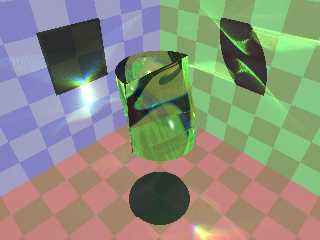|
 |
A friend had "invented / discovered" this shape some years ago.
Unfortunately all of his explanations seemed to verge on the
pseudo-scientific, so I tried to get a visualization to see if
the construct held together. Later I worked on rendering it
in POV-Ray, and this is the picture that I think best illustrates
all of the shape's properties in a single 2-D picture. I
particularly love the light flare on the blue wall -- it reminds
me of a dove.
-Scott
Post a reply to this message
Attachments:
Download 'dor.jpg' (100 KB)
Preview of image 'dor.jpg'

|
 |
|
 |
Scott David Daniels wrote:
> A friend had "invented / discovered" this shape some years ago.
> Unfortunately all of his explanations seemed to verge on the
> pseudo-scientific, so I tried to get a visualization to see if
> the construct held together. Later I worked on rendering it
> in POV-Ray, and this is the picture that I think best illustrates
> all of the shape's properties in a single 2-D picture. I
> particularly love the light flare on the blue wall -- it reminds
> me of a dove.
>
> -Scott
Nice ior demo, nice shape too. sin/cos waves?
I guess the black areas are deliberate silhouettes
rather than shadows, however it might be better if
they weren't so harsh.
Is there media in there or just a surface pigment?
--
Bill Hails
http://billhails.net/
Post a reply to this message
|
 |
|
 |
Bill Hails nous apporta ses lumieres en ce 24/06/2006 09:04:
> Scott David Daniels wrote:
>
>> A friend had "invented / discovered" this shape some years ago.
>> Unfortunately all of his explanations seemed to verge on the
>> pseudo-scientific, so I tried to get a visualization to see if
>> the construct held together. Later I worked on rendering it
>> in POV-Ray, and this is the picture that I think best illustrates
>> all of the shape's properties in a single 2-D picture. I
>> particularly love the light flare on the blue wall -- it reminds
>> me of a dove.
>>
>> -Scott
>
> Nice ior demo, nice shape too. sin/cos waves?
> I guess the black areas are deliberate silhouettes
> rather than shadows, however it might be better if
> they weren't so harsh.
> Is there media in there or just a surface pigment?
>
They ARE shadows, there are 3 lights, one for each axis. I don't see any evidence of
any media, no
radiosity. The finish must be ambient 0 and the lights placed as to only shine on the
surface facing
them.
--
Alain
-------------------------------------------------
Laughter is the shortest distance
between two people.
Post a reply to this message
|
 |
|
 |
Bill Hails wrote:
> Nice ior demo, nice shape too. sin/cos waves?
Thanks. Kind of a funny shape. He calls it a DOR because when you
build one, you can get a "Direct-Opposite-Reflected" image using it
as a lens (the trick is that one of the flat ends works as a mirror
on such projections).
Here's the shape:
#declare tip = function(vert) { sqrt(6.25 - vert*vert) - 1.5 }
#declare rad = function(h) {(h*h+1) / max(h,.000001) / 2}
#declare hgt = function(x,r,h) { sqrt(r*r - x*x) + h - r }
#declare hght= function(x,h) { hgt(x, rad(h), h) }
#declare height=function(x,y) { hght(x, tip(y+1)) }
#declare frontDOR=isosurface {
function { z * (z - hght(x, tip(y+1))) }
threshold 0
max_gradient 30
contained_by {box {<-1,-1,0>, <1,1,1>}}
all_intersections
}
#declare DOR=merge {
object { frontDOR }
object { frontDOR rotate <180,0,0> }
}
> I guess the black areas are deliberate silhouettes
> rather than shadows, however it might be better if
> they weren't so harsh.
They are shadows; the goal was to produce a single high-
quality image that showed his three orthographic views
and displayed the image as an easy-to believe/understand
3-D shape.
I suspect you are right about softening the shadows, but
probably the way to do that is add some fill lighting.
> Is there media in there or just a surface pigment?
No media, only colored lights.
Post a reply to this message
|
 |




![]()